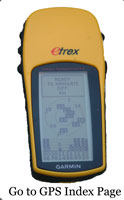 Measurement
of Long Tow calibration course with GPS
Measurement
of Long Tow calibration course with GPS Measurement
of Long Tow calibration course with GPS
Measurement
of Long Tow calibration course with GPSThe South side of Long Tow is 695.254m long when measured with an EDM. My steel tape agreed very closely with that value.
I have a total of 20 rides form East to West with GPS way marks recorded at each end. I calculated 20 values for the length using Pythagoras.
The 20 values for the length ranged from 690.0m to 699.7m. The average of the 20 values was 695.85 m which is 196 mm long
The standard deviation of an individual length was 2.49 m, So I would estimate the standard deviation of the average of 20 rides to be 2.49/sqrt(20) = 0.56 m.
In my article on the simulation of GPS measurements, for measuring a 1 sided polygon (ie a straight line) of length 695m I got a standard deviation of 3.2 m. The simulated standard deviation is 50% greater than the measured standard deviation. It is possible account for this difference if to some extent the GPS readings fluctuate on a timescale longer than it takes to ride on side of Long Tow. i.e. a times scale greater than about 2.5 minutes. This is quite feasible when one considers that the source of GPS errors include some such as ionospheric and atmospheric delays and ephemeris errors that change rather slowly with time.
Note that we can check that simulation is correct using the following argument. The Rayleigh distribution that fits my way points has a parameter of 3.3 m. Therefore the Eastings should be distributed as a Gaussian with a standard deviation of 3.3/sqrt(2) m. The difference between Eastings at the two ends of an East-West calibration course will then have a standard deviation of 3.3/sqrt(2)*sqrt(2)= 3.3 m very close to the result of the simulation, showing that the simulation gave the correct result.
The length of a straight calibration course can be measured using the separation of the waypoints recorded at each end with an standard deviation somewhat better than the 3.3 m which would be expected from the long term reproducibility of GPS waypoints taken over several days. This strongly suggests that over timescales of 2 to 3 minutes GPS errors are less than the errors observed over longer periods.
My GPS is not accurate enough to measure a calibration course which is to be used for calibrating a measuring bike. However, on of the checks that does have to be made when laying out a calibration course with a steel tape of 30 m of 50 m length, is that the correct number of tape lengths have been recorded. Since the GPS can be relied on to be less than 10m in error, it offers one possible means of checking that the count of tape lengths is correct.
The results so far strongly suggest that my ETREX H, while less accurate than a calibrated bike, should be capable of measuring a real race course with a considerable degree of accuracy perhaps only a factor of around 2 worse. In my next article I will examine the tracks recorded by GPS carried on my bicycle while I ride along the SPR of a real course.
Mike Sandford - 1 April 2009